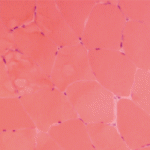Figueroa-Parra et al. set out to evaluate the effect of glucocorticoid regimens on renal response, infections and mortality rates among patients with lupus nephritis (LN). The researchers analyzed the control arms of randomized clinical trials and found a higher exposure to glucocorticoids during the initial treatment of LN was associated with better renal outcomes, at the cost of increased infections and mortality.

A High HAQ at Baseline in Early RA Is a Bad Sign
In this study, Fatima et al. analyzed how well the Health Assessment Questionnaire (HAQ) disability index predicts future all-cause mortality in patients with early RA (i.e., with a symptom duration of less than one year). A total of 1,724 patients with early RA were included. The researchers found that a higher HAQ score and Disease Activity Score at one year were significantly associated with all-cause mortality.

ANCA Mortality: Are Patients Doing Better?
Patients with anti-neutrophil cytoplasmic antibody–associated vasculitides (AAV) have an increased risk of mortality. But treatments have evolved in recent years. Recent research found that between 1999 and 2017 the AAV mortality rate declined by nearly 2% per year in patients 65–74 years old…
Mortality from Anti-neutrophil Cytoplasmic Autoantibody-Associated Vasculitis Falling Slightly
NEW YORK (Reuters Health)—Mortality rates in patients with antineutrophil cytoplasmic autoantibody-associated vasculitis (AAV) decreased from 1999 to 2017, according to records from the Centers for Disease Control and Prevention (CDC). “The mortality attributed to several rare diseases [e.g., hypersensitivity pneumonitis] has increased in recent years,” Alexander W. Steinberg, MD, from Saint Joseph Hospital, Denver, tells…
Osteoporosis Drugs Don’t Reduce Overall Mortality
NEW YORK (Reuters Health)—Anti-fracture medications do not reduce overall mortality in older patients with osteoporosis, according to an updated systematic review and meta-analysis. “This meta-analysis suggests drug treatments, including treatment with bisphosphonates, for osteoporosis should be recommended only for the prevention of fracture and not for any additional reduction in mortality,” researchers write in JAMA…
Lupus Pregnancy Outcomes Improved Over the Past 2 Decades
NEW YORK (Reuters Health)—Pregnancy outcomes in women with systemic lupus erythematosus (SLE) have improved markedly over the past two decades, although pregnancy risks remain higher than in women without lupus, according to a trends analysis. “Thirty years ago, most women with SLE were advised to avoid pregnancy because of high risks for maternal and fetal…
Mortality Trends in Lupus Nephritis
According to results of a recent study of all-cause and cause-specific mortality trends of end-stage renal disease due to lupus nephritis from 1995 to 2014, the all-cause premature mortality rate improved among white, African American and Hispanic patients, with reduced risk of death from CVD and infection. Jorge et al. observed a 32% reduction in mortality. This improved survival may be explained by a combination of improvements in the management of ESRD and of underlying SLE…

Large-Vessel Involvement Is an Independent Risk Factor Predicting GCA Mortality
At diagnosis, temporal artery biopsy results and large-vessel involvement of patients with giant cell arteritis may be stronger predictors of mortality than cardiovascular risk factors…
Weight Change in Early RA & the Risk of Mortality
Sparks et al set out to investigate whether weight change during the early RA period is associated with subsequent mortality and to evaluate whether there is an RA-specific effect. They investigated weight change during the early RA period, because this is the window of time during which weight change is most likely to be related to RA-specific processes. They found that severe weight loss during the early RA period was associated with a subsequent increased mortality risk both for women with and without RA…

Fellows’ Forum Case Report: Necrotizing Autoimmune Myopathy
Necrotizing autoimmune myopathy (NAM) is a relatively recently discovered subgroup of inflammatory myopathies. NAM is characterized by predominant muscle fiber necrosis and regeneration with little or no inflammation.1 One subgroup of NAM is 3-hydroxy-3-methylglutaryl-CoA reductase antibody (HMGCR Ab)-related immune-mediated necrotizing myopathy (IMNM), which occurs (rarely) after statin exposure, with a rough incidence of two per…